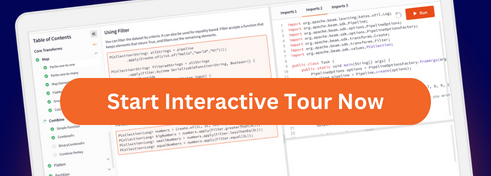Beam DataFrames overview
The Apache Beam Python SDK provides a DataFrame API for working with pandas-like DataFrame objects. The feature lets you convert a PCollection to a DataFrame and then interact with the DataFrame using the standard methods available on the pandas DataFrame API. The DataFrame API is built on top of the pandas implementation, and pandas DataFrame methods are invoked on subsets of the datasets in parallel. The big difference between Beam DataFrames and pandas DataFrames is that operations are deferred by the Beam API, to support the Beam parallel processing model. (To learn more about differences between the DataFrame implementations, see Differences from pandas.)
You can think of Beam DataFrames as a domain-specific language (DSL) for Beam pipelines. Similar to Beam SQL, DataFrames is a DSL built into the Beam Python SDK. Using this DSL, you can create pipelines without referencing standard Beam constructs like ParDo or CombinePerKey.
The Beam DataFrame API is intended to provide access to a familiar programming interface within a Beam pipeline. In some cases, the DataFrame API can also improve pipeline efficiency by deferring to the highly efficient, vectorized pandas implementation.
What is a DataFrame?
If you’re new to pandas DataFrames, you can get started by reading 10 minutes to pandas, which shows you how to import and work with the pandas package. pandas is an open-source Python library for data manipulation and analysis. It provides data structures that simplify working with relational or labeled data. One of these data structures is the DataFrame, which contains two-dimensional tabular data and provides labeled rows and columns for the data.
Pre-requisites
To use Beam DataFrames, you need to install Beam python version 2.26.0 or higher (for complete setup instructions, see the Apache Beam Python SDK Quickstart) and a supported pandas version. In Beam 2.34.0 and newer the easiest way to do this is with the “dataframe” extra:
pip install apache_beam[dataframe]
Note that the same pandas version should be installed on workers when executing DataFrame API pipelines on distributed runners. Reference base_image_requirements.txt for the Python version and Beam release you are using to see what version of pandas will be used by default on workers.
Using DataFrames
You can use DataFrames as shown in the following example, which reads New York City taxi data from a CSV file, performs a grouped aggregation, and writes the output back to CSV:
from apache_beam.dataframe.io import read_csv
with pipeline as p:
rides = p | read_csv(input_path)
# Count the number of passengers dropped off per LocationID
agg = rides.groupby('DOLocationID').passenger_count.sum()
agg.to_csv(output_path)
pandas is able to infer column names from the first row of the CSV data, which is where passenger_count and DOLocationID come from.
In this example, the only traditional Beam type is the Pipeline instance. Otherwise the example is written completely with the DataFrame API. This is possible because the Beam DataFrame API includes its own IO operations (for example, read_csv and to_csv) based on the pandas native implementations. read_* and to_* operations support file patterns and any Beam-compatible file system. The grouping is accomplished with a group-by-key, and arbitrary pandas operations (in this case, sum) can be applied before the final write that occurs with to_csv.
The Beam DataFrame API aims to be compatible with the native pandas implementation, with a few caveats detailed below in Differences from pandas.
Embedding DataFrames in a pipeline
To use the DataFrames API in a larger pipeline, you can convert a PCollection to a DataFrame, process the DataFrame, and then convert the DataFrame back to a PCollection. In order to convert a PCollection to a DataFrame and back, you have to use PCollections that have schemas attached. A PCollection with a schema attached is also referred to as a schema-aware PCollection. To learn more about attaching a schema to a PCollection, see Creating schemas.
Here’s an example that creates a schema-aware PCollection, converts it to a DataFrame using to_dataframe, processes the DataFrame, and then converts the DataFrame back to a PCollection using to_pcollection:
from apache_beam.dataframe.convert import to_dataframe
from apache_beam.dataframe.convert import to_pcollection
...
# Read the text file[pattern] into a PCollection.
lines = p | 'Read' >> ReadFromText(known_args.input)
words = (
lines
| 'Split' >> beam.FlatMap(
lambda line: re.findall(r'[\w]+', line)).with_output_types(str)
# Map to Row objects to generate a schema suitable for conversion
# to a dataframe.
| 'ToRows' >> beam.Map(lambda word: beam.Row(word=word)))
df = to_dataframe(words)
df['count'] = 1
counted = df.groupby('word').sum()
counted.to_csv(known_args.output)
# Deferred DataFrames can also be converted back to schema'd PCollections
counted_pc = to_pcollection(counted, include_indexes=True)
You can find the full wordcount example on GitHub, along with other example DataFrame pipelines.
It’s also possible to use the DataFrame API by passing a function to DataframeTransform:
from apache_beam.dataframe.transforms import DataframeTransform
with beam.Pipeline() as p:
...
| beam.Select(DOLocationID=lambda line: int(..),
passenger_count=lambda line: int(..))
| DataframeTransform(lambda df: df.groupby('DOLocationID').sum())
| beam.Map(lambda row: f"{row.DOLocationID},{row.passenger_count}")
...
DataframeTransform is similar to SqlTransform from the Beam SQL DSL. Where SqlTransform translates a SQL query to a PTransform, DataframeTransform is a PTransform that applies a function that takes and returns DataFrames. A DataframeTransform can be particularly useful if you have a stand-alone function that can be called both on Beam and on ordinary pandas DataFrames.
DataframeTransform can accept and return multiple PCollections by name and by keyword, as shown in the following examples:
output = (pc1, pc2) | DataframeTransform(lambda df1, df2: ...)
output = {'a': pc, ...} | DataframeTransform(lambda a, ...: ...)
pc1, pc2 = {'a': pc} | DataframeTransform(lambda a: expr1, expr2)
{...} = {a: pc} | DataframeTransform(lambda a: {...})



